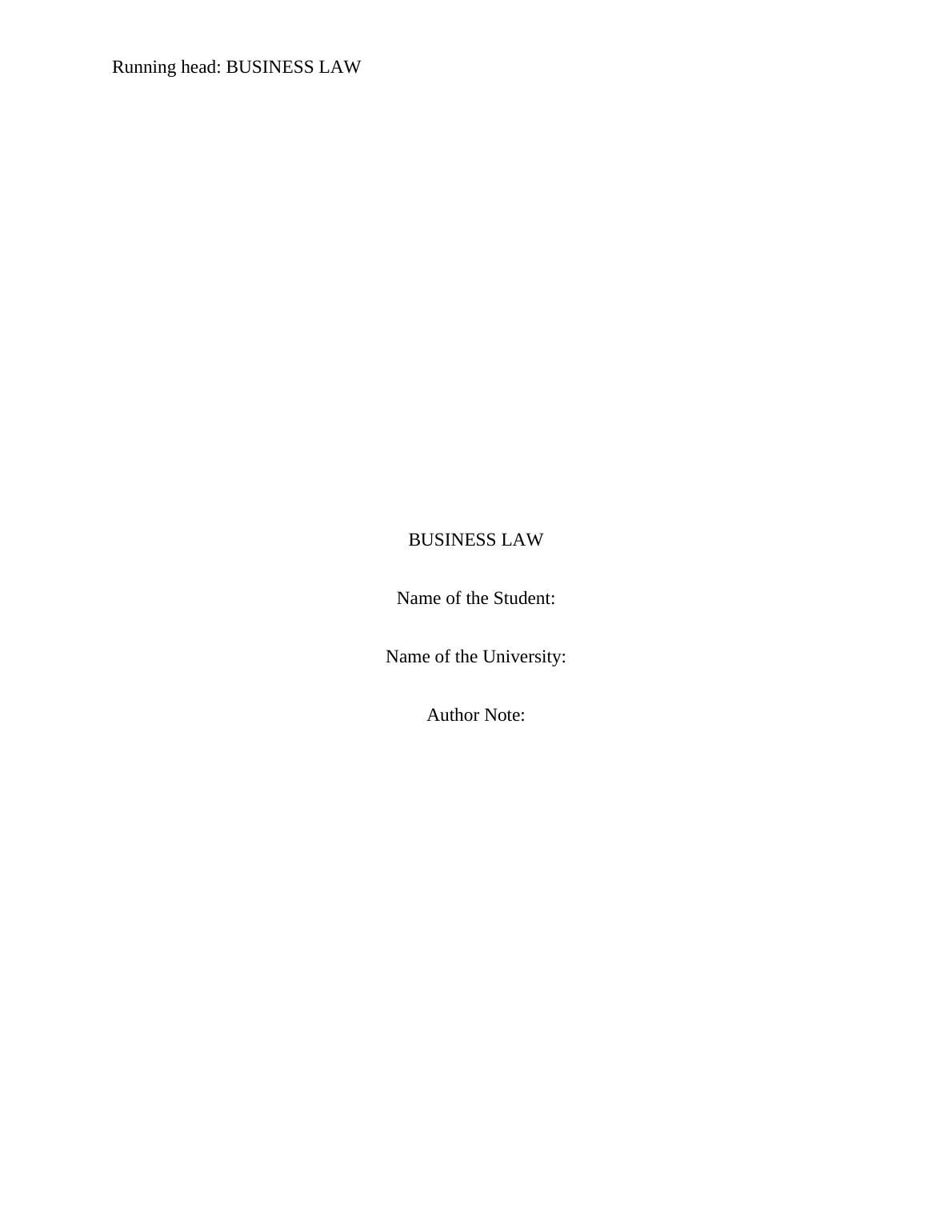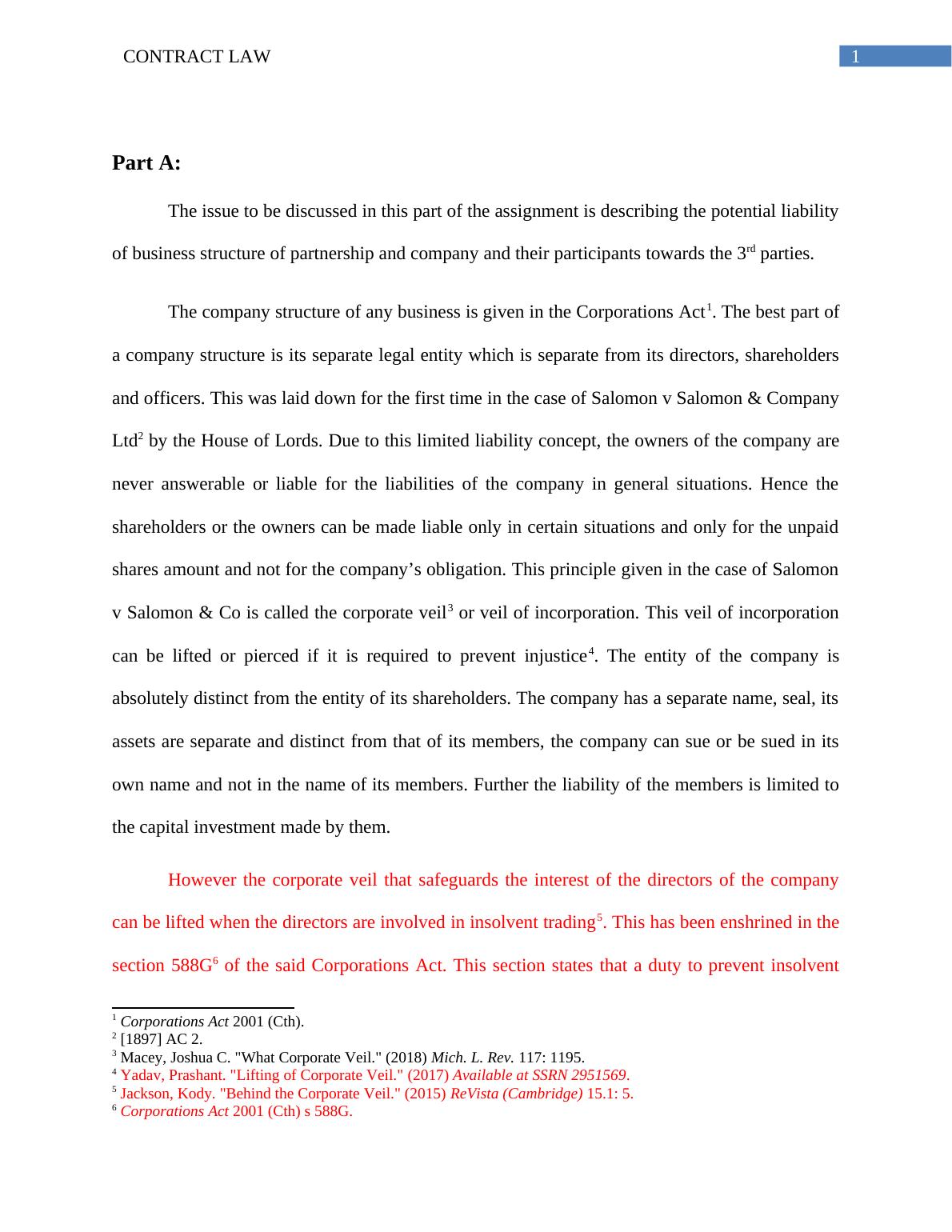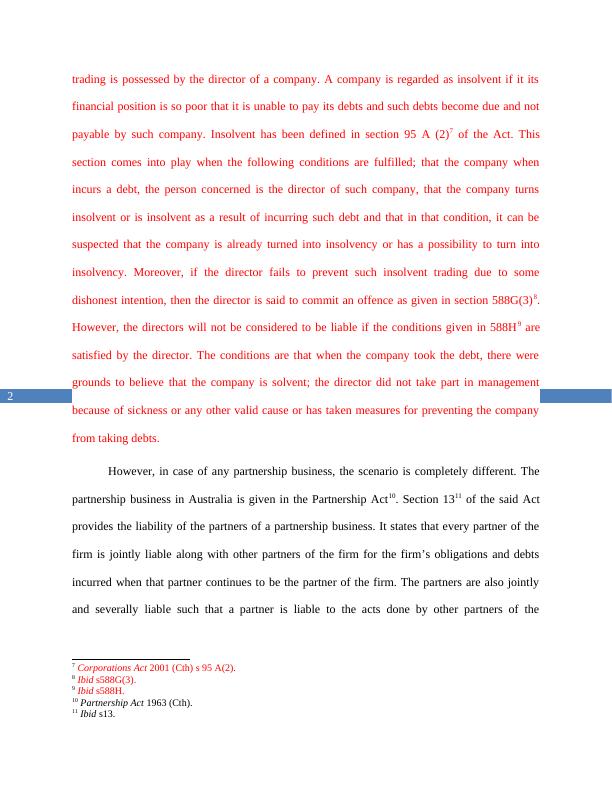Contract Law Assignment 2022
Added on 2022-09-18
15 Pages3607 Words23 Views
Running head: BUSINESS LAW
BUSINESS LAW
Name of the Student:
Name of the University:
Author Note:
BUSINESS LAW
Name of the Student:
Name of the University:
Author Note:

CONTRACT LAW1
Part A:
The issue to be discussed in this part of the assignment is describing the potential liability
of business structure of partnership and company and their participants towards the 3rd parties.
The company structure of any business is given in the Corporations Act1. The best part of
a company structure is its separate legal entity which is separate from its directors, shareholders
and officers. This was laid down for the first time in the case of Salomon v Salomon & Company
Ltd2 by the House of Lords. Due to this limited liability concept, the owners of the company are
never answerable or liable for the liabilities of the company in general situations. Hence the
shareholders or the owners can be made liable only in certain situations and only for the unpaid
shares amount and not for the company’s obligation. This principle given in the case of Salomon
v Salomon & Co is called the corporate veil3 or veil of incorporation. This veil of incorporation
can be lifted or pierced if it is required to prevent injustice4. The entity of the company is
absolutely distinct from the entity of its shareholders. The company has a separate name, seal, its
assets are separate and distinct from that of its members, the company can sue or be sued in its
own name and not in the name of its members. Further the liability of the members is limited to
the capital investment made by them.
However the corporate veil that safeguards the interest of the directors of the company
can be lifted when the directors are involved in insolvent trading5. This has been enshrined in the
section 588G6 of the said Corporations Act. This section states that a duty to prevent insolvent
1 Corporations Act 2001 (Cth).
2 [1897] AC 2.
3 Macey, Joshua C. "What Corporate Veil." (2018) Mich. L. Rev. 117: 1195.
4 Yadav, Prashant. "Lifting of Corporate Veil." (2017) Available at SSRN 2951569.
5 Jackson, Kody. "Behind the Corporate Veil." (2015) ReVista (Cambridge) 15.1: 5.
6 Corporations Act 2001 (Cth) s 588G.
Part A:
The issue to be discussed in this part of the assignment is describing the potential liability
of business structure of partnership and company and their participants towards the 3rd parties.
The company structure of any business is given in the Corporations Act1. The best part of
a company structure is its separate legal entity which is separate from its directors, shareholders
and officers. This was laid down for the first time in the case of Salomon v Salomon & Company
Ltd2 by the House of Lords. Due to this limited liability concept, the owners of the company are
never answerable or liable for the liabilities of the company in general situations. Hence the
shareholders or the owners can be made liable only in certain situations and only for the unpaid
shares amount and not for the company’s obligation. This principle given in the case of Salomon
v Salomon & Co is called the corporate veil3 or veil of incorporation. This veil of incorporation
can be lifted or pierced if it is required to prevent injustice4. The entity of the company is
absolutely distinct from the entity of its shareholders. The company has a separate name, seal, its
assets are separate and distinct from that of its members, the company can sue or be sued in its
own name and not in the name of its members. Further the liability of the members is limited to
the capital investment made by them.
However the corporate veil that safeguards the interest of the directors of the company
can be lifted when the directors are involved in insolvent trading5. This has been enshrined in the
section 588G6 of the said Corporations Act. This section states that a duty to prevent insolvent
1 Corporations Act 2001 (Cth).
2 [1897] AC 2.
3 Macey, Joshua C. "What Corporate Veil." (2018) Mich. L. Rev. 117: 1195.
4 Yadav, Prashant. "Lifting of Corporate Veil." (2017) Available at SSRN 2951569.
5 Jackson, Kody. "Behind the Corporate Veil." (2015) ReVista (Cambridge) 15.1: 5.
6 Corporations Act 2001 (Cth) s 588G.

CONTRACT LAW2
trading is possessed by the director of a company. A company is regarded as insolvent if it its
financial position is so poor that it is unable to pay its debts and such debts become due and not
payable by such company. Insolvent has been defined in section 95 A (2)7 of the Act. This
section comes into play when the following conditions are fulfilled; that the company when
incurs a debt, the person concerned is the director of such company, that the company turns
insolvent or is insolvent as a result of incurring such debt and that in that condition, it can be
suspected that the company is already turned into insolvency or has a possibility to turn into
insolvency. Moreover, if the director fails to prevent such insolvent trading due to some
dishonest intention, then the director is said to commit an offence as given in section 588G(3)8.
However, the directors will not be considered to be liable if the conditions given in 588H9 are
satisfied by the director. The conditions are that when the company took the debt, there were
grounds to believe that the company is solvent; the director did not take part in management
because of sickness or any other valid cause or has taken measures for preventing the company
from taking debts.
However, in case of any partnership business, the scenario is completely different. The
partnership business in Australia is given in the Partnership Act10. Section 1311 of the said Act
provides the liability of the partners of a partnership business. It states that every partner of the
firm is jointly liable along with other partners of the firm for the firm’s obligations and debts
incurred when that partner continues to be the partner of the firm. The partners are also jointly
and severally liable such that a partner is liable to the acts done by other partners of the
7 Corporations Act 2001 (Cth) s 95 A(2).
8 Ibid s588G(3).
9 Ibid s588H.
10 Partnership Act 1963 (Cth).
11 Ibid s13.
trading is possessed by the director of a company. A company is regarded as insolvent if it its
financial position is so poor that it is unable to pay its debts and such debts become due and not
payable by such company. Insolvent has been defined in section 95 A (2)7 of the Act. This
section comes into play when the following conditions are fulfilled; that the company when
incurs a debt, the person concerned is the director of such company, that the company turns
insolvent or is insolvent as a result of incurring such debt and that in that condition, it can be
suspected that the company is already turned into insolvency or has a possibility to turn into
insolvency. Moreover, if the director fails to prevent such insolvent trading due to some
dishonest intention, then the director is said to commit an offence as given in section 588G(3)8.
However, the directors will not be considered to be liable if the conditions given in 588H9 are
satisfied by the director. The conditions are that when the company took the debt, there were
grounds to believe that the company is solvent; the director did not take part in management
because of sickness or any other valid cause or has taken measures for preventing the company
from taking debts.
However, in case of any partnership business, the scenario is completely different. The
partnership business in Australia is given in the Partnership Act10. Section 1311 of the said Act
provides the liability of the partners of a partnership business. It states that every partner of the
firm is jointly liable along with other partners of the firm for the firm’s obligations and debts
incurred when that partner continues to be the partner of the firm. The partners are also jointly
and severally liable such that a partner is liable to the acts done by other partners of the
7 Corporations Act 2001 (Cth) s 95 A(2).
8 Ibid s588G(3).
9 Ibid s588H.
10 Partnership Act 1963 (Cth).
11 Ibid s13.

CONTRACT LAW3
business12. It shows that one partner can be made responsible for the acts done by any other
partner. Further, when a third party sues the partnership firm claiming damages, then the
personal property of the partners can be encroached which are not possible in case of a company
unless the member of the company is personally responsible for this. Section 913 of the Act
provides the powers of the partners to bind the firm as well as other partners. Partners can be
made liable to the outsider in certain situations like when a person, may or may not be a partner
have been authorized by the partners to enter into a transaction with an outsider on their behalf.
Again if the partners authorize one of the partners to act on their behalf with an outsider, then
every partner is bound by the act of such partner. Again if one partner of a firm without any
express authorization has acted in the circumstances mentioned in section 5 then other partners
will be bound by the act of such partner.
From the facts of the case it is seen that if the three members of the family wish to start a
restaurant food supply business for them. Of the three members, two members prefer the
partnership structure whereas the other one prefers company as the proper business structure. In
regard to the concern of the members in relation to whether the third parties can take legal steps
against them, the above mentioned rules can be discussed. It is seen that the company business
structure has some advantages over the partnership structure. Due to the separate legal identity of
the company, the company possesses separate legal identity than its members which is absent in
the case of a partnership business. The advantage of the company structure is that the members
have separate entity from the company. The members cannot be sued or their personal property
cannot be encroached upon by any third party due to the corporate veil. Moreover, one member
cannot be made liable jointly and severally for the act of the other members, But these are not
12 Ghatak, Maitreesh. "Screening by the company you keep: Joint liability lending and the peer selection effect." The
Economic Journal 110.465: 601-631.
13 Partnership Act 1963 (Cth) s9.
business12. It shows that one partner can be made responsible for the acts done by any other
partner. Further, when a third party sues the partnership firm claiming damages, then the
personal property of the partners can be encroached which are not possible in case of a company
unless the member of the company is personally responsible for this. Section 913 of the Act
provides the powers of the partners to bind the firm as well as other partners. Partners can be
made liable to the outsider in certain situations like when a person, may or may not be a partner
have been authorized by the partners to enter into a transaction with an outsider on their behalf.
Again if the partners authorize one of the partners to act on their behalf with an outsider, then
every partner is bound by the act of such partner. Again if one partner of a firm without any
express authorization has acted in the circumstances mentioned in section 5 then other partners
will be bound by the act of such partner.
From the facts of the case it is seen that if the three members of the family wish to start a
restaurant food supply business for them. Of the three members, two members prefer the
partnership structure whereas the other one prefers company as the proper business structure. In
regard to the concern of the members in relation to whether the third parties can take legal steps
against them, the above mentioned rules can be discussed. It is seen that the company business
structure has some advantages over the partnership structure. Due to the separate legal identity of
the company, the company possesses separate legal identity than its members which is absent in
the case of a partnership business. The advantage of the company structure is that the members
have separate entity from the company. The members cannot be sued or their personal property
cannot be encroached upon by any third party due to the corporate veil. Moreover, one member
cannot be made liable jointly and severally for the act of the other members, But these are not
12 Ghatak, Maitreesh. "Screening by the company you keep: Joint liability lending and the peer selection effect." The
Economic Journal 110.465: 601-631.
13 Partnership Act 1963 (Cth) s9.

End of preview
Want to access all the pages? Upload your documents or become a member.
Related Documents
Duties of Directors in Company and Partnership Structureslg...
|9
|2711
|1
Legal Actions Against Susan and Mary for Violation of Corporations Actlg...
|8
|2192
|187
Partnership Law Assignment 2022lg...
|9
|2344
|18
Corporate Law: Legal Entity, Insolvent Trading, Internal Management, Remedieslg...
|9
|2724
|70
Corporate Veil and Limited Liability in International Business Lawlg...
|13
|4988
|284
Liability of David towards Nu Shampoo Pty Ltd and Standard Banklg...
|8
|1962
|85
